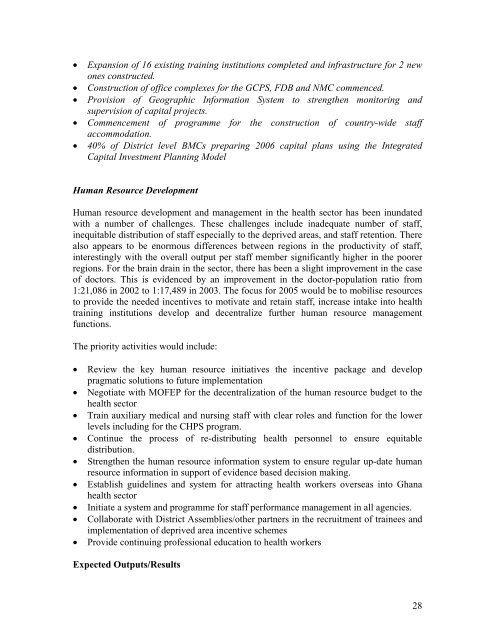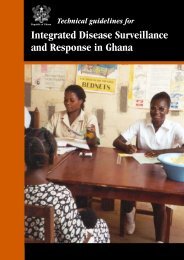Annual Programme of Work 2005 - Ministry of Health
Annual Programme of Work 2005 - Ministry of Health
Annual Programme of Work 2005 - Ministry of Health
You also want an ePaper? Increase the reach of your titles
YUMPU automatically turns print PDFs into web optimized ePapers that Google loves.
• Expansion <strong>of</strong> 16 existing training institutions completed and infrastructure for 2 new<br />
ones constructed.<br />
• Construction <strong>of</strong> <strong>of</strong>fice complexes for the GCPS, FDB and NMC commenced.<br />
• Provision <strong>of</strong> Geographic Information System to strengthen monitoring and<br />
supervision <strong>of</strong> capital projects.<br />
• Commencement <strong>of</strong> programme for the construction <strong>of</strong> country-wide staff<br />
accommodation.<br />
• 40% <strong>of</strong> District level BMCs preparing 2006 capital plans using the Integrated<br />
Capital Investment Planning Model<br />
Human Resource Development<br />
Human resource development and management in the health sector has been inundated<br />
with a number <strong>of</strong> challenges. These challenges include inadequate number <strong>of</strong> staff,<br />
inequitable distribution <strong>of</strong> staff especially to the deprived areas, and staff retention. There<br />
also appears to be enormous differences between regions in the productivity <strong>of</strong> staff,<br />
interestingly with the overall output per staff member significantly higher in the poorer<br />
regions. For the brain drain in the sector, there has been a slight improvement in the case<br />
<strong>of</strong> doctors. This is evidenced by an improvement in the doctor-population ratio from<br />
1:21,086 in 2002 to 1:17,489 in 2003. The focus for <strong>2005</strong> would be to mobilise resources<br />
to provide the needed incentives to motivate and retain staff, increase intake into health<br />
training institutions develop and decentralize further human resource management<br />
functions.<br />
The priority activities would include:<br />
• Review the key human resource initiatives the incentive package and develop<br />
pragmatic solutions to future implementation<br />
• Negotiate with MOFEP for the decentralization <strong>of</strong> the human resource budget to the<br />
health sector<br />
• Train auxiliary medical and nursing staff with clear roles and function for the lower<br />
levels including for the CHPS program.<br />
• Continue the process <strong>of</strong> re-distributing health personnel to ensure equitable<br />
distribution.<br />
• Strengthen the human resource information system to ensure regular up-date human<br />
resource information in support <strong>of</strong> evidence based decision making.<br />
• Establish guidelines and system for attracting health workers overseas into Ghana<br />
health sector<br />
• Initiate a system and programme for staff performance management in all agencies.<br />
• Collaborate with District Assemblies/other partners in the recruitment <strong>of</strong> trainees and<br />
implementation <strong>of</strong> deprived area incentive schemes<br />
• Provide continuing pr<strong>of</strong>essional education to health workers<br />
Expected Outputs/Results<br />
28















